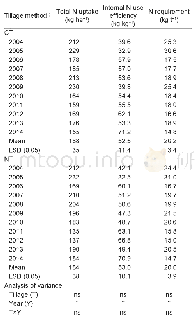《Table 3 Input data required by the selected hydrological and water quality models[22, 23, 37, 38, 5
 提示:宽带有限、当前游客访问压缩模式
提示:宽带有限、当前游客访问压缩模式
本系列图表出处文件名:随高清版一同展现
《Suitability of common models to estimate hydrology and diffuse water pollution in North-eastern German lowland catchments with intensive agricultural land use》
Note:*Provided as input or calculated by the model.
For N transport and transformations,ECO Lab and HSPF are better and include the N cycle in comparison to SWIM and SWAT.A problem in using SWAT for nitrogen transformation is the use of only built-in parameters and new parameters cannot be included.MIKE SHE has a shell or module called ECO Lab which has the tendency to model the nitrogen transformations in the river and desired parameters can be added accordingly.SWAT and SWIM do not have the ability to simulate the soil nitrogen and in terms of interflow which is a considerable part in case of the Tollense River basin.SWAT and SWIM can only model NO3–,while ECO Lab and HSPF can predict both NO3–and NH4tin interflow.Interflow inorganic N,however,can only be simulated with ECO Lab.The case of groundwater flow follows the same pattern,with SWIM and SWAT only predicting NO3–,while ECO Lab can predict NO3–,NH4tand dissolved N,whereas HSPF can only predict the first two.Nitrification,denitrification and decomposition can be handled by all tools.For plant uptake,SWAT and SWIM can only simulate inorganic N taken up by plants,whereas,HSPF cannot model inorganic N but can model NO3–,NH4t,and ECO Lab can handle all three parameters.These differences are summarized in Table 5.
| 图表编号 | XD0017390000 严禁用于非法目的 |
|---|---|
| 绘制时间 | 2018.12.01 |
| 作者 | Muhammad WASEEM、Frauke KACHHOLZ、Jens TRNCKNER |
| 绘制单位 | Faculty of Agriculture and Environmental Sciences,University of Rostock、Faculty of Agriculture and Environmental Sciences,University of Rostock、Faculty of Agriculture and Environmental Sciences,University of Rostock |
| 更多格式 | 高清、无水印(增值服务) |
查看“Table 3 Input data required by the selected hydrological and water quality models[22, 23, 37, 38, 53–55, 63–67]”的人还看了
-

- Table 3 Descriptive statistics of input and output indexes in Northeast China in 2014 at the county scale
-

- Table 5 The citrus input and output index data of various monitoring counties in Jiangxi Province in 2013
-

- Table 2 Total N uptake, internal N-use efficiency, and N requirements in hybrid rice transplanted with single seedlings





